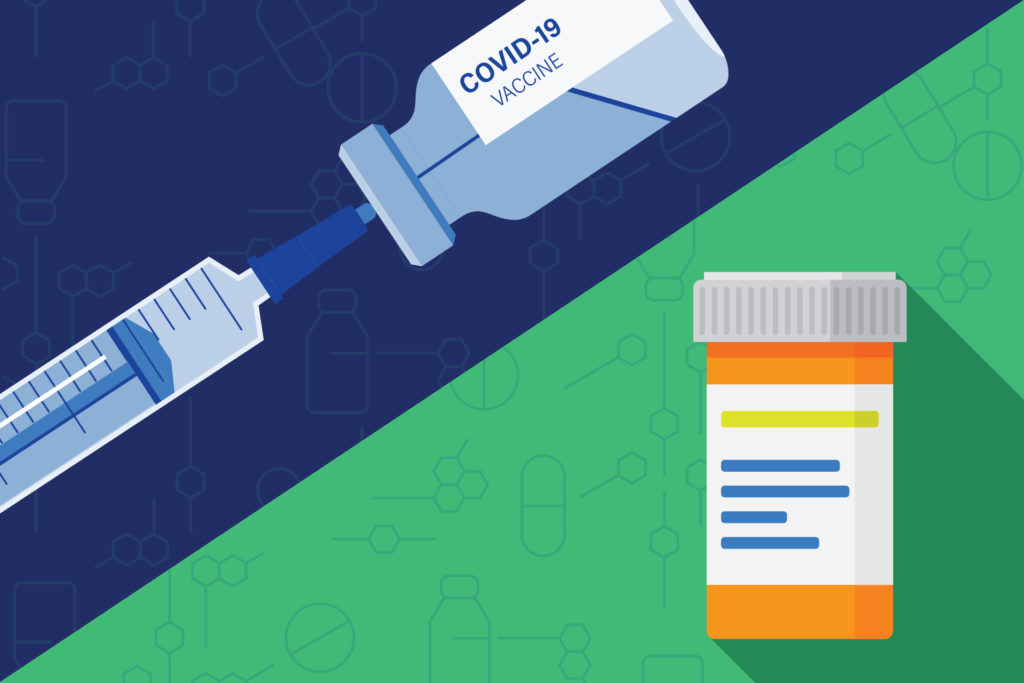Introduction
Recent data from Johns Hopkins University showed over 760,000 people in the U.S. have died from the coronavirus to date. According to a September 2021 report from the CDC, unvaccinated people are 10 times more likely to get hospitalized and die from COVID-19 than fully vaccinated people. COVID-19 vaccines can protect against infection but if you’re already infected, antiviral drugs can lessen the risk of hospitalization and death. In just a few months since our last article on COVID-19 treatments, there have been some exciting developments. There are a number of antiviral drugs in development, and a couple of oral antiviral treatments that have shown much promise early in the course of the disease and Emergency Use Authorizations (EUAs) may be on the way. This has caused a wave of anticipation, since current successful treatments to date are monoclonal antibody medicines that require infusions at healthcare facilities. Our most recent insight shares a summary of the latest Covid-19 treatment developments.
New Oral Treatments on the Horizon
Molnupiravir – Merck/Ridgeback
Molnupiravir is an investigational oral antiviral medicine being studied for the treatment of mild-to-moderate COVID-19 in adults who are at risk for progressing to severe COVID-19 and/or hospitalization. Merck submitted an EUA with the FDA on October 11, 2021. This submission is based on positive results from an interim analysis of its Phase III MOVe-OUT trial which showed molnupiravir reduced the risk of hospitalization or death by approximately 50%. The incidence of drug-related adverse events was also comparable between molnupiravir and placebo. Molnupiravir should be taken orally twice a day for five days. Merck has a $1.2 billion supply agreement with the U.S. government which has committed to purchasing approximately 1.7 million courses of molnupiravir once it gets the EUA. A course of molnupiravir reportedly costs $17.74 to produce, and the U.S. will pay more than $700 per treatment course, representing a 40-fold markup. Merck expects to produce 10 million courses of molnupiravir by the end of 2021. An FDA advisory committee is scheduled to meet on Nov. 30, 2021, to review the EUA with a decision by the FDA likely in December.
As the U.S. is reviewing Merck’s EUA application, the United Kingdom has already authorized molnupiravir to treat COVID-19. Much has been said about only the richest countries having access to the precious COVID vaccines and treatments while poorer countries get pushed to the back of the line. To help address this, Merck has signed a licensing agreement with the UN-backed Medicines Patent Pool (MPP) which will allow other companies to produce generic versions of molnupiravir without having to pay royalties. Merck said this would apply to 105 low- and middle-income countries as long as the World Health Organization classifies the pandemic as a “Public Health Emergency of International Concern.”
Paxlovid (PF-07321332; ritonavir) – Pfizer
Another experimental oral COVID-19 treatment has shown promising interim results from its Phase 2/3 Study, EPIC-HR. Paxlovid is a combination of Pfizer’s new protease inhibitor (PF-07321332) plus ritonavir. Paxlovid (PF-07321332; ritonavir) was found to be 89% effective in preventing hospitalization and death in mild-to-moderate COVID-19 patients. PF-07321332 binds to an enzyme called a protease to stop the virus from replicating. It is co-administered with low-dose ritonavir, which slows the breakdown of PF-07321332 so that it remains active in the body longer to help combat the virus. It’s designed to be taken orally at the first sign of infection or awareness of exposure to COVID-19. Paxlovid is to be taken orally twice daily for 5 days. The incidence of drug-related adverse events was comparable between Paxlovid and placebo. Based on these interim results, Pfizer will submit its EUA application to the U.S. regulators as soon as possible. Once authorized or approved, Pfizer expects to manufacture 180,000 treatment courses by the end of 2021, and at least 50 million courses by the end of 2022.
Following in the footsteps of Merck, Pfizer has just announced a similar licensing agreement with the UN-backed Medicines Patent Pool (MPP). This will allow other companies to produce generic versions of molnupiravir without having to pay royalties in 95 developing countries. Merck’s agreement covers 105 developing countries.
Current treatments for COVID-19 are monoclonal antibodies that need to be infused at a healthcare facility. It may be difficult for some patients to get to these facilities to receive the infusions, especially the elderly. In lower income countries, having access to these infusions would be near impossible for much of the population. Having effective, oral treatments that can be taken at home will be an important tool to control the pandemic not only in the U.S. but globally, as long as it’s widely accessible. While it seems like the U.S. government will foot the bill for these treatments for now, payers will need to anticipate budget impact once these drugs are FDA approved.







